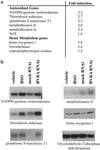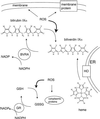Biliverdin reductase: a major physiologic cytoprotectant
- PMID: 12456881
- PMCID: PMC138570
- DOI: 10.1073/pnas.252626999
Biliverdin reductase: a major physiologic cytoprotectant
Abstract
Bilirubin, an abundant pigment that causes jaundice, has long lacked any clear physiologic role. It arises from enzymatic reduction by biliverdin reductase of biliverdin, a product of heme oxygenase activity. Bilirubin is a potent antioxidant that we show can protect cells from a 10,000-fold excess of H2O2. We report that bilirubin is a major physiologic antioxidant cytoprotectant. Thus, cellular depletion of bilirubin by RNA interference markedly augments tissue levels of reactive oxygen species and causes apoptotic cell death. Depletion of glutathione, generally regarded as a physiologic antioxidant cytoprotectant, elicits lesser increases in reactive oxygen species and cell death. The potent physiologic antioxidant actions of bilirubin reflect an amplification cycle whereby bilirubin, acting as an antioxidant, is itself oxidized to biliverdin and then recycled by biliverdin reductase back to bilirubin. This redox cycle may constitute the principal physiologic function of bilirubin.
Figures





Comment in
-
The jaundice of the cell.Proc Natl Acad Sci U S A. 2002 Dec 10;99(25):15837-9. doi: 10.1073/pnas.012685199. Epub 2002 Dec 2. Proc Natl Acad Sci U S A. 2002. PMID: 12461187 Free PMC article. No abstract available.
References
Publication types
MeSH terms
Substances
Grants and funding
LinkOut - more resources
Full Text Sources
Other Literature Sources
Medical
Molecular Biology Databases

